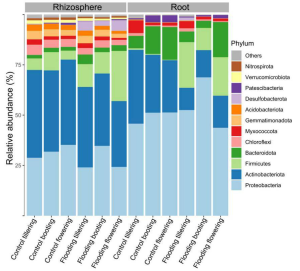A group from Microbial Biogeochemistry, Research Area Landscape Functioning, Leibniz Center for Agricultural Landscape Research e.V., Müncheberg, Germany, etc. has reported effects of flooding on spring wheat rhizosphere.
https://www.ncbi.nlm.nih.gov/pmc/articles/PMC8602104/
Flooding caused followings,
(i) significant increase of bacterial taxa with anaerobic respiratory capabilities, such as members of Firmicutes and Desulfobacterota,
(ii) a significant reduction in Actinobacteria and Proteobacteria,
(iii) depletion of several putative plant-beneficial taxa, and
(iv) increases of the abundance of potential detrimental bacteria.
To be more specific, flooding promoted an enrichment of the genera Geobacter and Clostridium. It is known that several Clostridium species might cause soft rot disease in several vegetable crops and their abundance significantly increased with heavy rainfall and flooding. On the other hand, a dramatic reduction of the abundance of Streptomyces and Spinghomonas occurred in all flooding samples, which have been described as beneficial for wheat growth. Members of these two genera, are able to solubilize inorganic phosphorus, to form siderophores and affect phytohormones production and might be involved in biocontrol activity.
Bacteria affiliated to the genus Saccharimonadia, which shows putative beneficial features such as improving nitrogen uptake efficiency and promoting nutrient conversion, were mainly depleted in flooded roots. A similar trend was observed in the rhizosphere for families Rhizobiaceae and Xanthobacteraceae.
Members of different Massilia species are considered as putatively plant-beneficial (in terms of producing proteases, sidephores and the auxin indole-3-acetic acid). Massilia ASVs were significantly more abundant in the control roots of young plants, but they were not detected in those of the flooded ones. Likewise, the flooded wheat roots at booting stage revealed a significant reduction of Flavobacterium ASVs, which are known for plant growth promoting traits. Bacteria of this genus have the capabilities to solubilize phosphate, use of 1-amino cyclopropan-1-carboxylate as sole nitrogen source and production of auxin, siderophores, salicylic acid, antifungal chitinases and hydrogen cyanide.
In summary, these findings demonstrated that flooding significantly altered negatively the assemblage dynamics of the root microbiota, with a significant depletion of putatively beneficial bacterial taxa associated with the root and rhizosphere of spring wheat plant.

